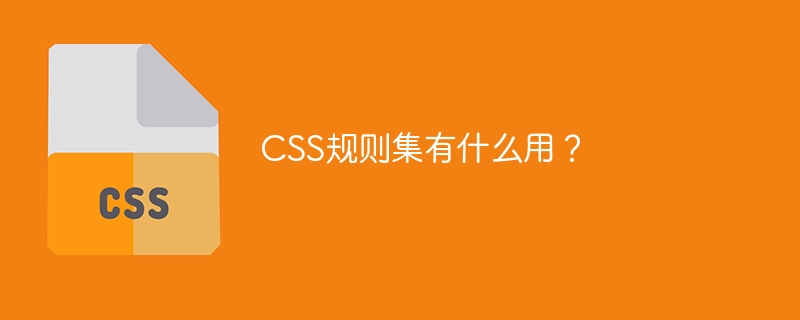CSS規則集有什麼用?

CSS 代表層疊樣式表。它用於設定 HTML 元素的樣式。 HTML 用於建立網頁或在網頁上新增內容。之後,開發人員使用 CSS 以特定樣式呈現 HTML 內容,使其看起來很棒。
CSS規則集主要包含兩部分。一個是 CSS 選擇器,另一個是聲明區塊。
CSS選擇器用於選擇HTML元素,宣告區塊包含鍵值格式的CSS屬性以套用於HTML元素。
文法
使用者可以依照下列語法使用 CSS 規則集來設定 HTML 元素的樣式。
selector {
/* declaration block */
}
在上面的語法中,‘selector’可以是HTML元素的類別名稱、id等,用來選擇HTML元素。聲明區塊包含多個 CSS 屬性及其值以套用於 HTML 元素。
範例 1(CSS 類別名稱選擇器)
在下面的範例中,我們在定義 CSS 規則集時使用類別名稱作為 CSS 選擇器。下面的程式碼中有三個 div 元素,其中包含不同的類別名稱。我們透過類別名稱選擇了每個 div 元素,並應用了不同的 CSS 樣式,使用者可以在輸出中觀察到。
<html>
<head>
<style>
.one {
background-color: red;
color: white;
padding: 10px;
margin: 10px;
border: 1px solid green;
}
.two {
background-color: green;
color: white;
padding: 10px;
margin: 10px;
border: 3px solid yellow;
}
.three {
background-color: blue;
color: white;
padding: 10px;
margin: 10px;
border: 2px solid pink;
}
</style>
</head>
<body>
<h2 id="Using-the-i-class-selector-i-in-CSS-ruleset"> Using the <i> class selector </i> in CSS ruleset </h2>
<div class = "one"> One </div>
<div class = "two"> Two </div>
<div class = "three"> Three </div>
</body>
</html>
範例 2(CSS ID 選擇器)
在下面的範例中,我們在定義 CSS 規則集時使用 HTML 元素的 id 作為 CSS 選擇器。在 HTML 中,兩個元素永遠不能包含相同的 id。
這裡,我們有一個 id 為「card」的 div 元素,其中包含另外兩個 id 等於「content1」和「content2」的 div 元素。我們透過 ID 存取所有 HTML 元素來設定它們的樣式,使用者可以在輸出中觀察到這些元素。
<html>
<head>
<style>
#card {
width: 140px;
height: 300px;
background-color: grey;
border-radius: 12px;
border: 2px solid red;
display: flex;
justify-content: space-between;
flex-direction: column;
}
#content1 {
width: 100px;
height: 100px;
background-color: blue;
border-radius: 12px;
color: white;
border: 2px solid red;
margin: 20px;
}
#content2 {
width: 100px;
height: 100px;
color: white;
background-color: blue;
border-radius: 12px;
border: 2px solid red;
margin: 20px;
}
</style>
</head>
<body>
<h2 id="Using-the-i-id-selector-i-in-CSS-ruleset"> Using the <i> id selector </i> in CSS ruleset </h2>
<div id = "card">
<div id = "content1"> HTML </div>
<div id = "content2"> CSS </div>
</div>
</body>
</html>
範例 3(CSS 多重選擇器)
在下面的範例中,我們使用多個 CSS 選擇器一次將相同的 CSS 樣式套用到多個 HTML 元素。
我們有三個具有不同類別名稱和 ID 的
元素。在 CSS 中,我們使用「.text1、.text2、#para1」CSS 選擇器將聲明區塊中新增的相同樣式套用到所有 HTML 元素。
此外,我們還使用類別名稱和 ID CSS 選擇器分別選擇了所有三個 HTML 元素,以便在不同元素上套用不同的樣式。
<html>
<head>
<style>
.text1,
.text2,
#para1 {
margin: 10px;
height: auto;
padding: 10px;
width: 200px;
}
.text1 {
background-color: red;
color: white;
font-size: 2rem;
}
.text2 {
background-color: green;
color: red;
font-size: 1.7rem;
}
#para1 {
background-color: blue;
color: white;
font-size: 1rem;
}
</style>
</head>
<body>
<h2 id="Using-the-i-Multiple-selector-i-in-CSS-ruleset"> Using the <i> Multiple selector </i> in CSS ruleset </h2>
<p class = "text1"> This is the first paragraph </p>
<p class = "text2"> This is a second paragraph. </p>
<p id = "para1"> This is the third paragraph. </p>
</body>
</html>
範例 4(CSS 巢狀元素選擇器)
在下面的範例中,我們介紹了CSS的巢狀選擇器。在 HTML 中,div 元素包含多個類別名為「link」的 元素。
在 CSS 中,我們使用了「div .link」CSS 選擇器,它選擇類別名為「link」的所有 HTML 元素以及 div 元素的後代。如果我們使用「div.link」作為 CSS 選擇器,它會將樣式套用到所有類別名為「link」的 div 元素。因此,「div.link」和「div .link」都是不同的 CSS 選擇器。
在輸出中,使用者可以觀察到 CSS 樣式套用於所有 HTML 元素,這些元素是 div 元素的後代,但未套用於 div 元素外部的元素。
<html>
<head>
<style>
div .link {
color: red;
text-decoration: none;
}
</style>
</head>
<body>
<h2 id="Using-the-i-nested-selectors-i-in-CSS-ruleset"> Using the <i> nested selectors </i> in CSS ruleset </h2>
<div>
<a href = "#" class = "link"> Link1 </a>
<a href = "#" class = "link"> Link2 </a>
<a href = "#" class = "link"> Link3 </a>
</div><br>
<a href = "#" class = "link"> Link 5 </a>
</body>
</html>
範例 5(CSS 偽選擇器)
在此範例中,我們示範了 CSS 偽選擇器的使用。 CSS 偽選擇器有很多種,我們在這裡使用了其中的一些。
這裡,我們有一個「container」div 元素,其中包含 4 個具有「element」類別名稱的子元素。當使用者將滑鼠懸停在 div 元素上時,我們使用“:hover”偽選擇器來更改“container”div 元素的背景顏色。
之後,我們使用':first-child'、':last-child' 和':nth-child()' CSS 選擇器以及'.element' 選擇器來選擇第一個子元素、最後一個子元素,和第n個孩子,分別。
在輸出中,使用者可以觀察到不同的 CSS 樣式應用於第一個子項目、最後一個子項目和第二個子項目。
<html>
<head>
<style>
.container {
height: 100px;
width: 500px;
background-color: blue;
padding: 10px;
display: flex;
justify-content: space-around;
border-radius: 12px;
font-size: 1.2rem;
}
/* hover pseudo class */
.container:hover {
background-color: red;
}
/* first child pseudo class */
.element:first-child {
background-color: green;
color: white;
}
/* last child pseudo class */
.element:last-child {
background-color: grey;
color: black;
}
/* nth child pseudo class */
.element:nth-child(2) {
background-color: pink;
color: green;
}
</style>
</head>
<body>
<h2 id="Using-the-i-pseudo-selectors-i-in-CSS-ruleset"> Using the <i> pseudo selectors </i> in CSS ruleset </h2>
<div class = "container">
<div class = "element"> First Child </div>
<div class = "element"> Second Child </div>
<div class = "element"> Third Child </div>
<div class = "element"> Fourth Child </div>
</div>
</body>
</html>
使用者在本教學中學習如何使用不同的 CSS 規則集。我們使用類別名稱和 id 作為選擇器。此外,我們還學習了使用多個 CSS 選擇器和巢狀 CSS 選擇器。在上一個範例中,我們學習如何使用 CSS 規則集中的偽選擇器。
以上是CSS規則集有什麼用?的詳細內容。更多資訊請關注PHP中文網其他相關文章!

熱AI工具

Undresser.AI Undress
人工智慧驅動的應用程序,用於創建逼真的裸體照片

AI Clothes Remover
用於從照片中去除衣服的線上人工智慧工具。

Undress AI Tool
免費脫衣圖片

Clothoff.io
AI脫衣器

Video Face Swap
使用我們完全免費的人工智慧換臉工具,輕鬆在任何影片中換臉!

熱門文章

熱工具

記事本++7.3.1
好用且免費的程式碼編輯器

SublimeText3漢化版
中文版,非常好用

禪工作室 13.0.1
強大的PHP整合開發環境

Dreamweaver CS6
視覺化網頁開發工具

SublimeText3 Mac版
神級程式碼編輯軟體(SublimeText3)
 每周平台新聞:HTML加載屬性,主要的ARIA規格以及從iframe轉移到Shadow dom
Apr 17, 2025 am 10:55 AM
每周平台新聞:HTML加載屬性,主要的ARIA規格以及從iframe轉移到Shadow dom
Apr 17, 2025 am 10:55 AM
在本週的平台新聞綜述中,Chrome引入了一個用於加載的新屬性,Web開發人員的可訪問性規範以及BBC Move
 我們如何標記Google字體並創建Goofonts.com
Apr 12, 2025 pm 12:02 PM
我們如何標記Google字體並創建Goofonts.com
Apr 12, 2025 pm 12:02 PM
Goofonts是由開發人員和設計師丈夫簽名的附帶項目,它們都是版式的忠實擁護者。我們一直在標記Google
 它全部都在頭上:管理帶有React頭盔的React Power Site的文檔頭
Apr 15, 2025 am 11:01 AM
它全部都在頭上:管理帶有React頭盔的React Power Site的文檔頭
Apr 15, 2025 am 11:01 AM
該文檔負責人可能不是網站上最迷人的部分,但是其中所處的內容對於您的網站的成功也一樣重要











